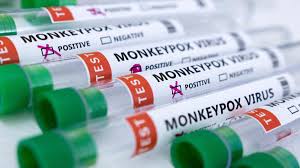
Monkeypox is a disease that can spread from animals to humans. It is caused by the monkeypox virus, which is part of the orthopox virus group and belongs to the Poxviridae family. Recently, in 2022, it was in the news when cases were reported outside of Africa, where it usually occurs. India, particularly Kerala, has reported cases that caused public health issues, leading to many preventive and controlling actions.
Monkeypox:
An Overview Monkeypox is a viral disease that has almost identical manifestations to those of smallpox but is less virulent. It was first confirmed in humans in 1970 in the Democratic Republic of the Congo (DRC), where the virus has appeared sporadically in Central and West Africa. The primary mode of transmission from a natural reservoir, like rodents or primates, to a human or by direct contact from another infected person.
Fever, headache, sore muscles, and rash with fluid-filled blisters are included in the disease symptoms. The illness lasts for a period of 2 to 4 weeks.
There are two distinct groups of the monkeypox virus: the Central African (Congo Basin) group and the West African group. The Congo Basin group was responsible in the past for a more severe illness with higher mortality rates.
Monkeypox in Kerala
One of the southern states of India, Kerala acts very rapidly during health crises. This is mainly based on cases of Nipah virus and a COVID-19 outbreak. The state’s health facilities are robust, but the monkeypox outbreak is alarming. According to the reports, monkeypox can lead to severe cases within merely two days and primarily targets weaker groups.
First Cases in Kerala
The first case of monkeypox was confirmed from Kerala in the month of July 2022. This was in an individual who had traveled back to India from the United Arab Emirates (UAE). It was the first confirmed case in India. Subsequent cases were detected in Kerala, mostly among individuals who had traveled out of the country. Subsequently, the surveillance, testing, and contact tracing of health authorities in Kerala were strengthened to curb the subsequent transmission.
Symptoms and Spread
The monkeypox virus primarily spreads through touching sores of the infected person, or his body fluids, or his respiratory droplets. It also occurs through contaminated objects with the virus, such as clothing and bedding. Most cases in Kerala were thought to be due to close personal contact or travel-related exposure.
Symptoms usually begin with fever, bad headaches, and swollen lymph nodes, accompanied by a rash that begins on the face and then spreads all over the body. Then, after some time, the sores dry and fall off. It often disappears, meaning it subsides within weeks, but in some cases, especially in weakened immune systems of people or young children, it can be severe or even fatal.
Public Health Action
The Kerala government reacted swiftly to the new disease outbreak. Upon the first case diagnosis, the government established the state’s health protocols. The patient was isolated, and contacts traced, and it awaits the appearance of symptoms among close contacts. Health officials stationed hospitals with isolation facilities and increased the capacity for diagnosis.
Kerala has faced many health problems, such as the reappearance of the Nipah virus in 2018 and 2021 and the widespread pandemic of COVID-19. The state has been working hard to fight new infectious diseases like monkeypox. Officials asked people to stay calm while promoting good hygiene and social distancing with anyone who might have the disease.
Government Measures and Guidelines
After the cases of monkeypox were reported in the country, some steps were implemented by the Indian government and the government of Kerala to stop the spread of the virus.
Screening at Airports:
The first approach was to introduce screening in the international airports. People who were entering the state from places where cases were detected started being screened for fever and rashes. Kerala, which harbors huge numbers of its population working outside in countries, mostly in the Middle East, paid special importance to in-bound passengers from there.
Isolation Protocols:
People who are suspected or confirmed to have the monkeypox virus are kept in special health facilities. This isolation lasts for several weeks, depending on when the patient gets better and all symptoms, especially rashes, go away.
Contact tracing:
The Kerala State Health Department used contact tracing to identify people who might have had the opportunity of contracting the virus as they were in proximity with a confirmed case. They followed up on these contacts in case they exhibited symptoms, and some were quarantined and prevented from further spreading the disease.
Training Health Workers:
Most health workers were not conversant with the monkeypox virus; thus, the state government started training programs for them. This encompassed everything related to symptom recognition, proper handling of suspected cases, infection prevention, and management of patients.
Public awareness campaign:
Kerala should start campaigns to educate people on the symptoms of monkeypox and how it spreads, thereby making everyone aware of the right ways of not spreading it. The myth of people through such wrong information need to be cleared.
Central Government Support:
The Indian Ministry of Health and Family Welfare has issued guidelines to contain the monkeypox infection. They have issued clinical guidelines with an aim of preventing and controlling the infection. In this context, the National Institute of Virology, Pune, Maharashtra, should send samples for testing to confirm if there is any presence of the monkeypox virus in it.
Prevention and Control
Good numbers of measures are adopted for the prevention of monkeypox.
The main preventive measures include:
Avoid Contact with Infected People or Animals. If a person is developing symptoms of an infection, avoid getting close to him/her. This also means that do not share personal items or clothes with an infected person. Wash your hands with soap and water or rub them with an alcohol-based hand rub.
Personal Protective Equipment:
Care of suspected or confirmed cases of monkeypox should be performed by using personal protective equipment to minimize one’s exposure to the virus.
Vaccination:
While smallpox vaccines may provide some protection against the disease, there isn’t any approved vaccine to use in India. In other countries, it had been administered to at-risk groups to prevent further spread of this outbreak. If cases continue to rise in India, this method will most likely be considered. While the Kerala government was proactive and took some steps to contain it, a long way still needs to be gone. Chances of proliferation due to international travel are going to persist as a challenge – a symptom of the global outbreak in 2022. The second challenge in dealing with serious cases relates to a specific vaccine or a well-known antiviral treatment for monkeypox. Besides, public health experts should ensure that this disease should not be stigmatized, specific to the infected. In case people are discriminated against by this disease, then the early or efficient treatment will be hindered and enhanced spread.
Conclusion
So far, monkeypox in Kerala has been very well controlled because health authorities have been prompt in taking containment measures, and they involved the public in spreading awareness. The experience from other viral outbreaks handled in the past has made a difference in what is being executed in Kerala about responses in cases of monkeypox. Vigilance and cooperation from the public shall be the key, together with probably the presentation of vaccines in totally eradicating the potential threat that may post monkeypox in this region.




